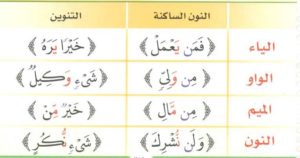Tajweed is a science of pronouncing the Quranic words, and one of its branches is Idgham, Idgham means Slurring which is housing the first letter and inter it in the pronunciation of the second letter. lets go through Idgham in Quran and understand more about it.
What is Idgham:
Idgham has several meanings. Idgham in language, is inserting a thing in another, so, it means inserting a letter in another, or slurring. And Idgham in terminology is confluence of a consonant letter with a vowel one, so these two letters become one letter, and pronounced as one letter with a weight of two letters. To understand Idgham more, we will go deeper in its meaning; Idgham is related to presence of “Static Noon” or “Nunation” and also related to “Static Meem”, and there are what are called letters of Idgham which are; (Yaa, Raa, Meem, Lam, Waw, Noon), and to apply the Idgham, the Static Noon or the Nunation or the Static Meem, should come at the end of a word, and the letter of Idgham should come at the beginning of the next word.Types of Idgham:
Idgham related to “Static Noon” or “Nunation”:
The first type of it, is “Idgham with nasalization”, and nasalization is a sound comes out from the nose , Idgham with nasalization is applied with certain letters of the letters of Idgham which are; (Yaa, Noon, Meem, Waw), and they are called “letters of Idgham with nasalization”, where the “Static Noon” or “Nunation” comes at the end of a word and a “letter of Idgham with nasalization” comes at the beginning of the next word. Second type of Idgham is “Idgham without nasalization”, and it is related to only two letters of Idgham which are, (Raa and Lam), and are called “letters of Idgham without nasalization”.Idgham related to “Static Meem”:
If a “Static Meem” comes in a word and followed by a “vowel Meem”, so, the reader should insert the pronunciation of the Static Meem in the pronunciation of the vowel Meem, and the Static Meem here, should be a Meem with sokoon, not Meem that is been suspended for being coming at the end of a word or a sentence, and also not the Static Meem that is been pronounced as vowel Meem to prevent the confluence of two static letters as in (Qm Al-layl) where “m” is static Meem, and “A” is a static Alif, and here the Meem is pronounced with Kasra as “mi” to be (Qmi Layl), and in these cases the Idgham is not applied.Types of Idgham concerning the symmetry:
Symmetrical Idgham:
it becomes between two same letters when one of them comes constant at the end of a word, and the other cames vowel at the beginning of the next word, as in (Ithhab- biketabik), as you can see, the letter “b” came at the end of the first word in static state, and came again at the beginning of the second word in Kasra state “bi”.Homogeneous Idgham:
it becomes between two letters which are same in the exit of pronunciation, but different in character as in (qd-ta’lmoon) as you can see, the “d” came in static state in the end of the first word, and the “t” came in Fatiha stat “ta”, and note that these two letters are different but are pronounced from the same exit (d&t) they both are pronounced from the top of the tongue with the origins of the upper folds..Converging Idgham:
it becomes between two letters which are convergent in their exit of pronunciation, but different in character, as in (QL-Rappy) as you can see the “L” came in static state, and followed with “R” in the Fatiha state “Ra”, and these two letters are convergent in their exit of pronunciation, as “L” is pronounced from the interior edge of the tongue with the help of teeth, and “R” is pronounced from the edge of the tongue with the help of upper gum.This shortcode LP Profile only use on the page Profile



